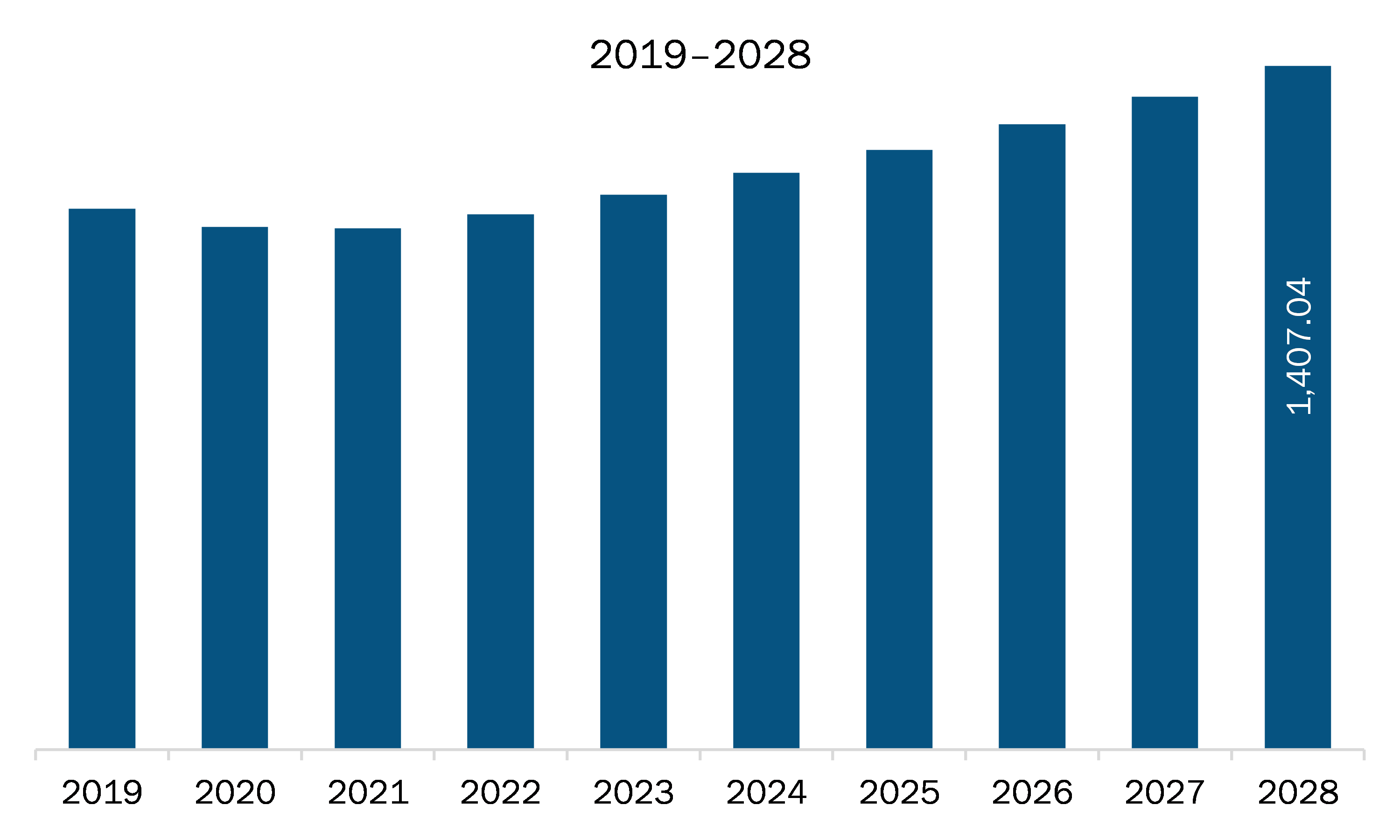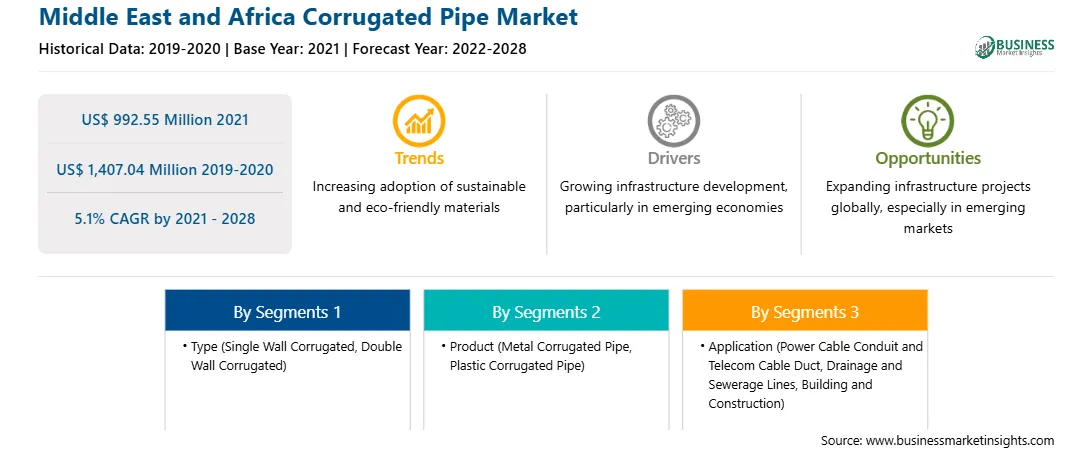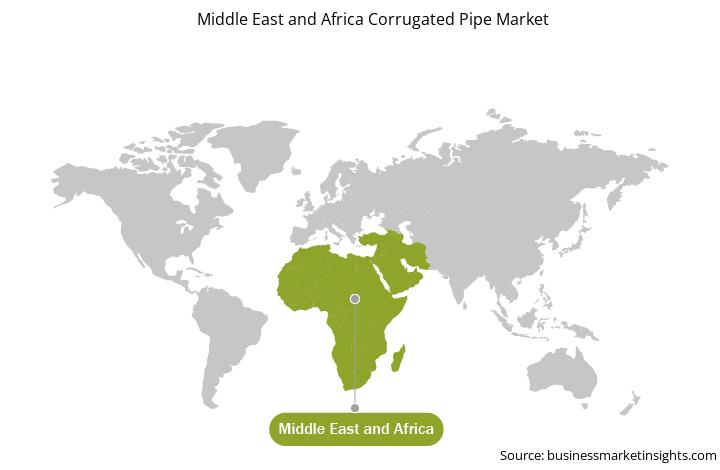The Middle East and Africa corrugated pipe market is a highly fragmented market with the presence of considerable regional and local players providing numerous solutions for companies investing in the market arena. Plastic corrugated pipes are ideal for electrical conduit and cable ducting, found within building walls and underneath roads and walkways. Corrugated electrical and cable ducting protect infrastructure from the damage caused by electricity, telecommunications, lighting, and other utilities. The pipes made from polyethylene, polypropylene, and polyvinyl chloride are used in these applications. Corrugated pipes are produced in continuous length which minimizes the number of required joints; it also makes them flexible as well as easier to transport, which allows the installers to easily lay the pipes around obstacles. Smooth inner layer minimizes the friction, and the outer corrugated layer provides strength while minimizing the weight. Corrugated steel pipes are used in the construction industry due to their ability to withstand the stress exerted by heavy traffic and unstable foundations. Corrugated polyethylene pipes are being used at agricultural sites for field drainage and soil moisture control, and in stock ponds. These pipes are also deployed for providing grain aeration at agricultural sites. Thus, the suitability of corrugated pipes made from different materials in a wide range of applications is bolstering their demand, thus drive the market growth.
In Middle East and Africa, South Africa reported a huge number of COVID-19 cases, which led to the discontinuation of several business operations, including corrugated pipe manufacturing activities. The disruptions in production and supply chain have had a negative impact on the corrugated pipe market in the early 2021. However, the monitoring and managing of wastewater have become more important in the pandemic and the treatment of waste management including medical, household, and other hazardous waste, as an urgent and essential public service to minimize possible secondary impacts on health and the environment. With cases rising in many parts of the developing region, there has been an increased focus to take an integrated approach to waste management that focuses on recycling and reducing waste. Governments of various countries are focusing on wastewater segregation, which sees black water, gray water and water laden with toxic chemicals siphoned off into separate municipal streams. This, focus on wastewater management is positively affecting the corrugated pipe market growth.

Strategic insights for the Middle East and Africa Corrugated Pipe provides data-driven analysis of the industry landscape, including current trends, key players, and regional nuances. These insights offer actionable recommendations, enabling readers to differentiate themselves from competitors by identifying untapped segments or developing unique value propositions. Leveraging data analytics, these insights help industry players anticipate the market shifts, whether investors, manufacturers, or other stakeholders. A future-oriented perspective is essential, helping stakeholders anticipate market shifts and position themselves for long-term success in this dynamic region. Ultimately, effective strategic insights empower readers to make informed decisions that drive profitability and achieve their business objectives within the market.

| Report Attribute | Details |
|---|---|
| Market size in 2021 | US$ 992.55 Million |
| Market Size by 2028 | US$ 1,407.04 Million |
| Global CAGR (2021 - 2028) | 5.1% |
| Historical Data | 2019-2020 |
| Forecast period | 2022-2028 |
| Segments Covered |
By Type
|
| Regions and Countries Covered | Middle East and Africa
|
| Market leaders and key company profiles |
The geographic scope of the Middle East and Africa Corrugated Pipe refers to the specific areas in which a business operates and competes. Understanding local distinctions, such as diverse consumer preferences (e.g., demand for specific plug types or battery backup durations), varying economic conditions, and regulatory environments, is crucial for tailoring strategies to specific markets. Businesses can expand their reach by identifying underserved areas or adapting their offerings to meet local demands. A clear market focus allows for more effective resource allocation, targeted marketing campaigns, and better positioning against local competitors, ultimately driving growth in those targeted areas.

The corrugated pipe market in Middle East and Africa is expected to grow from US$ 992.55 million in 2021 to US$ 1,407.04 million by 2028; it is estimated to grow at a CAGR of 5.1% from 2021 to 2028. While the coronavirus pandemic has damaged prospects across many of the region's traditional business areas, it has raised the outlook for water and wastewater investment in the Middle East and North Africa. Water security has long been a priority in the Middle East and Africa, characterized by a lack of lakes, rivers, and rainfall. The pandemic has refocused Middle East states on the vital importance of water security. According to Business Wire, Inc.; approximately $80bn-worth of water and wastewater projects are currently planned or underway across the Gulf Cooperation Council. Governments are backing large-scale strategic investment programs in order to improve water production and storage capacity, develop wastewater and sewage treatment, and revive dilapidated water transmission and distribution networks. The corrugated pipes are majorly used in sewerage projects in industrial waste transport, stormwater drainage, and transport the drainage waters by culvert pipes. Besides, these offer multiple years of trouble-free operation in infrastructure projects. Corrugated pipes ensure longer life of the filling being laid solid ground by drain lines, as drain tubes, culvert pipe systems for draining the undesired waters from the areas. These factors are predicted to boost the demand for corrugated pipe in the Middle East and Africa region.
Based on type, the double wall corrugated segment accounted for the largest share of the Middle East and Africa corrugated pipe market in 2020. Based on product, the plastic corrugated pipe segment accounted for the largest share of the Middle East and Africa corrugated pipe market in 2020. Based on application, the drainage and sewage lines segment accounted for the largest share of the Middle East and Africa corrugated pipe market in 2020.
A few major primary and secondary sources referred to for preparing this report on the Middle East and Africa corrugated pipe market are company websites, annual reports, financial reports, national government documents, and statistical database, among others. Major companies listed in the report include Advanced Drainage Systems; Bina Plastic Industries Sdn Bhd; Jain Irrigation Systems Ltd.; Dura Life India; Fränkische Industrial Pipes Gmbh and Co. KG; JM Eagle Inc.; and Pars Ethylene Kish Co.
The Middle East and Africa Corrugated Pipe Market is valued at US$ 992.55 Million in 2021, it is projected to reach US$ 1,407.04 Million by 2028.
As per our report Middle East and Africa Corrugated Pipe Market, the market size is valued at US$ 992.55 Million in 2021, projecting it to reach US$ 1,407.04 Million by 2028. This translates to a CAGR of approximately 5.1% during the forecast period.
The Middle East and Africa Corrugated Pipe Market report typically cover these key segments-
The historic period, base year, and forecast period can vary slightly depending on the specific market research report. However, for the Middle East and Africa Corrugated Pipe Market report:
The Middle East and Africa Corrugated Pipe Market is populated by several key players, each contributing to its growth and innovation. Some of the major players include:
The Middle East and Africa Corrugated Pipe Market report is valuable for diverse stakeholders, including:
Essentially, anyone involved in or considering involvement in the Middle East and Africa Corrugated Pipe Market value chain can benefit from the information contained in a comprehensive market report.